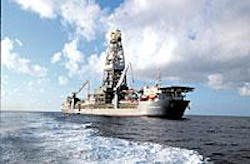BOP-deployed move saves time, money
Similar transitions anticipated
Above the water line, there was nothing special about the Discoverer Spirit's five-mile, eight-hour hop from one Mississippi Canyon block to another. But anyone ducking down about 6,600 ft would find the blowout preventer (BOP) still deployed from the 2000-build dual activity dynamically positioned vessel.
"We shifted with all of that deployed, saving probably a week's time," said Discoverer Spirit Rig Manager Logan Puckett.
The Discoverer Spirit is working on the TotalFinaElf-operated Canyon Express project in 7,000-ft water depth in the Gulf of Mexico. The Canyon Express development will combine production from three deepwater oil fields:
- BP-operated King's Peak on DeSoto Canyon Block 177
- Elf-operated Aconcagua on Mississippi Canyon Block 305
- Marathon Oil-operated Camden Hills on Mississippi Canyon Block 348.
The project, expected to go on line in 2Q 2002, will be tied back 53 miles. The Canyon Express participants are excited about the potential time-savings associated with moving while the BOP is deployed, Puckett said, noting that each transition will likely save millions of dollars. Canyon partners include Baker Hughes, BP, Marathon, Mariner Energy, and TotalFinaElf.
At the first well site, the dual-activity rig deployed the BOP stack with one rotary table to the stub of a wellhead and deployed the production tree with the second rotary table.
"We set the production tree and then pretty well immediately connected the BOP," Puckett said. The Discoverer Spirit then disconnected and left the BOP and riser in the water.
"We picked it up just slightly to keep from skidding it on the floor," he said. "You have seafloor bathymetrics and seafloor surveys, so you have a good idea."
The move
The vessel moved from Camden Hills at Mississippi Canyon Block 348 No. 2 in 7,209-ft water depth to Aconcagua at Mississippi Canyon Block 305 No. 2 in 7,001-ft water depth with the BOP pulled up about 400 ft off the sea floor.
The Discoverer Spirit started its five-mile trip going less than one nautical mile per hour and built up to a knot, keeping a close eye on how the riser moved, Puckett said. The Discoverer Spirit would typically have clipped along at nine knots. Despite the slow speed of the field-to-field move, it was still far less time than if the BOP had been pulled all the way up and then redeployed over a 72-hour or more period.
Future moves will be decided individually to determine if the time spent traveling at one knot per hour will make up for the amount of time spent deploying and pulling up the BOP, he said.
A firm schedule is not set for the Discoverer Spirit, but it is booked to work at other wells in the Canyon Express project through July or August, Puckett said. The work is not scheduled yet, he said, because of the fluid nature of the project, in which spudding, pipelaying, and umbilical work is occurring simultaneously.
Pioneers
But the Discoverer Spirit did not fashion its own new moves with the BOP deployed.
R&B Falcon, acquired by Transocean Sedco Forex in February 2001, used the same method off Brazil, and the Discoverer Spirit's sister vessel, the 1999-build Discoverer Enterprise, employed the technique in the Gulf of Mexico.
"It's been done in the Gulf of Mexico, particularly on template developments where there were previously drilled wells," Puckett said.
Some semisubmersibles were shifting anchors in moves of 100 ft or so five years ago and were "pretty proud of that," he said.
"Discoverer Enterprise has pioneered a whole lot of this," Puckett said. The Discoverer Enterprise used the BOP-deployed move in January 2001, while moving at Mississippi Canyon Block 217 No. 3 in 6,407 ft water depth in Kings Peak Field. The Discoverer Enterprise spent the last seven months of 2000 with its BOP in the water, moving from 3,400-ft water depth to 5,400-ft water depth to 6,900-ft water depth.
"We had no issues that would compromise the operability or safety of our BOP system," Discoverer Enterprise Rig Manager Larry McMahan said.


